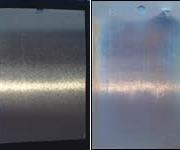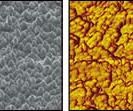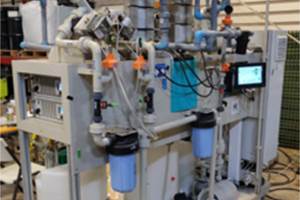Pretreatments: The Next Generation
Emerging technologies can save energy, ease environmental concerns
Concerns over rising energy costs and tightening environmental discharge limitations have driven research and development of alternative pretreatment technologies. These products may be identified by specific trade names or by general descriptions such as nanotechnology, silane technology or phosphorus-free pretreatment.
Most of these emerging technologies react similarly because they contain similar key components for creating a surface conversion. These fluoro-based chemistries not only operate at ambient temperature, but they also generate minimal sludge while producing a corrosion-resistant finish that can even improve over conventional iron phosphate with addition of various non-regulated transition metals or polymers.
Most suppliers are using zirconium, vanadium, titanium or silicon-based compounds with or without organic or inorganic polymerization. A quick look at the periodic table of elements shows that these materials are located in the same general area as chromium, a material that has been used for long-term corrosion resistance for years.
The coupling of these materials with an organic polymeric component has led to significant new opportunities in pretreatment.
Different suppliers are using variations in these new chemistries to achieve specific results. A look at the products available from several suppliers reveals many similarities but some individual distinctions that may offer benefits different from other products.
To better understand the options available in new pretreatment technologies, we asked several prominent chemical suppliers about their products.
Alternative Metals
Along with phosphates, zinc and nickel ions have been the backbone of the phosphate process for the last 60 years. Many pretreatment companies are investing in research to develop a conversion coating that limits dependence on zinc and nickel, and in some cases on phosphate, while complying with new
regulations.
Developing a suitable replacement hasn’t been easy. Suppliers have evaluated nanoparticles, zirconium, vanadium, titanium, polymers and other metal ions either by themselves or in combination. Some of the resulting processes require heating; others do not. Coating weights can vary from supplier to supplier, but overall they are lower than a traditional zinc phosphate with a range anywhere from 15–100 mg/sq ft depending on the chemistry. Lower-coating-weight technologies have a tendency to produce thinner coatings, which could shorten processing times if the rate of deposition is the same or faster.
Many of the new, more environmentally friendly coatings are based on mixed metal oxides using zirconium as a base. They deposit a conversion coating that’s free of regulated heavy metals and phosphate. Elimination of heavy metals allows such systems to remain virtually sludge-free and minimizes wastewater treatment issues.
Zirconium-based coatings are often applied in multi-metal operations, and often require no heat. Elimination of process heating saves energy, and additional savings can be realized if water volume, waste disposal and sludge are reduced. In most cases, the new conversion coating technologies can reduce the number of pretreatment stages required, resulting in a shortened process and reduced maintenance requirements.
Table 1 compares the actual sequence of conventional iron and zinc phosphate to a zirconium oxide pretreatment. Stages that require process heating are indicated with an asterisk (*).
As seen in the table, the iron phosphate and zirconium-based pretreatments each have two heated stages, while the zinc phosphate has three. Energy savings from such a change could run to $50,000 per year or more at a typical plant.
Additional cost savings are realized from reduced water consumption and reduced waste treatment requirements, because zirconium oxide-type coatings do not generate the sludge of conventional processes. At $25/ton to dispose of sludge from a zinc phosphate system that generates approximately 1,000 tons/year, annual cost savings become significant.
Fewer stages and fewer heated stages also mean lower maintenance costs, so there may be additional savings in labor and maintenance materials. Overall, uses may potentially save up to $100,000 annually.
Zirconium oxide pretreatments produce coatings weighing from 5–100 mg/sq ft at fairly rapid rates that can again reduce the size of the overall manufacturing line. By comparison, zinc phosphate coatings range in weight from 150–300 mg/sq ft.
Despite their lighter weight, zirconium oxide pretreatments may provide sufficient corrosion and adhesion performance when used with a good substrate and paint system. Corrosion performance may still be somewhat inferior to zinc phosphate, but it does pass many specifications.
In many ways these products may sound too good to be true, but every technology has limitations. Zirconium-based pretreatments typically work best in stainless steel pretreatment systems and can be hard on carbon steel systems. They often require very good water quality, so DI or RO water may be needed. They are relatively intolerant of line stoppages. Cost projections should take these issues into account, keeping in mind that cost per gallon is also going to be higher—maybe by up to 40%—than conventional iron phosphate pretreatment products.
Silane Chemistries
Other emerging pretreatment products are silane-based chemistries that use nanoscale technology to provides good corrosion resistance and coating adhesion excellent results without heat. Like zirconium-based pretreatments, these formulations also save waste disposal and maintenance costs by reducing sludge. There may also be savings in rinse water consumption, because the rinse following the treatment is cleaner than the rinse following a phosphate treatment.
The silane molecule is a silicon atom combined with an organic molecule. More complex silanes, described by the supplier as “organofunctional,” are used in these products. The organofunctional silane molecule has a group that reacts and forms stable bonds with metals or metal hydroxides and a group that reacts and forms stable bonds with organic groups in paint resins.
Organofunctional silanes are reacted with water in the chemical manufacturing facility to form polycondensates which retain the paint and metal-bonding properties of the silane in a more environmentally friendly form.
Performance is further improved by using non-regulated metals to selectively and preferentially bond to the metal substrate, providing better corrosion performance than a silane-only chemistry. Composition of these metals in the high-performance silane product is carefully balanced to provide the ideal deposition rate of the metal onto the substrate, which optimizes coating performance.
Silane-based products can be used in conventional three-stage pretreatment systems, and may be able to use typical city water. More stages and higher-purity water may be necessary, however, for finished products that require higher standards of corrosion resistance.
Aluminum Substrates
Aluminum surfaces must be treated before coating application to ensure coating adhesion and corrosion resistance, and chromates have long been used for aluminum products that will be used in an outdoor environment. Chrome has a long history as a high-quality method for prevention of corrosion, but sensitivity to environmental and worker safety issues associated with chrome has driven the market to look for alternatives.
One new product that has shown some unique properties is not a conversion coating, and it doesn’t contain metals. According to the supplier, it does not form a crystalline layer, require dwell time to build a film, or require removal or destruction of surface oxides to build a film. It also doesn’t sludge or require chemical tests to operate.
So how does it work? By forming a covalent bond directly with aluminum oxide, the chemical produces a thin, hydrophobic barrier coating capable of protecting aluminum from further oxidation by blocking access to the surface by corrosive materials.
Referred to as a sol-gel, the chemistry produces a very thin solid film 50–500 nm thick. Unlike conventional aluminum pretreatments, it does not involve removing the protective oxide layer that naturally exists on aluminum substrates. Rather, pretreatment molecules are designed to penetrate deep into nano-pores in the aluminum oxide and self-assemble up to 100 layers of highly cross-linked polymer.
Working solution concentration can be adjusted to control coating thickness. A higher solution concentration will produce a thicker coating for corrosion control on bare aluminum surfaces, and a lower concentration will produce a thinner coating for paint pretreatment. Organic functional groups in the polymer bond directly with any applied coating or paint, according to the supplier.
Related Content
Pretreatment of Black Oxide
Having issues achieving a consistent color with the application of black oxide? Start by looking at your pretreatment. Connor Callais of Hubbard-Hall offers advice for troubleshooting your black oxide process.
Read MoreTTX Environmental Solves Customer Issue with Electro-Ceramic Desalination Wastewater Processing
Electroplating facility without access to a drainage system found a safe solution for wastewater treatment and reuse.
Read MoreZinc Phosphate: Questions and Answers
Our experts share specific questions about zinc phosphate and pretreatment
Read More3-Stage Versus 5-Stage Washers
Columnist Rodger Talbert explains the difference between a five-stage washer and a three-stage washer, and how one provides better corrosion protection over the other.
Read MoreRead Next
Episode 45: An Interview with Chandler Mancuso, MacDermid Envio Solutions
Chandler Mancuso, technical director with MacDermid Envio discusses updating your wastewater treatment system and implementing materials recycling solutions to increase efficiencies, control costs and reduce environmental impact.
Read MoreDelivering Increased Benefits to Greenhouse Films
Baystar's Borstar technology is helping customers deliver better, more reliable production methods to greenhouse agriculture.
Read MoreA ‘Clean’ Agenda Offers Unique Presentations in Chicago
The 2024 Parts Cleaning Conference, co-located with the International Manufacturing Technology Show, includes presentations by several speakers who are new to the conference and topics that have not been covered in past editions of this event.
Read More

























